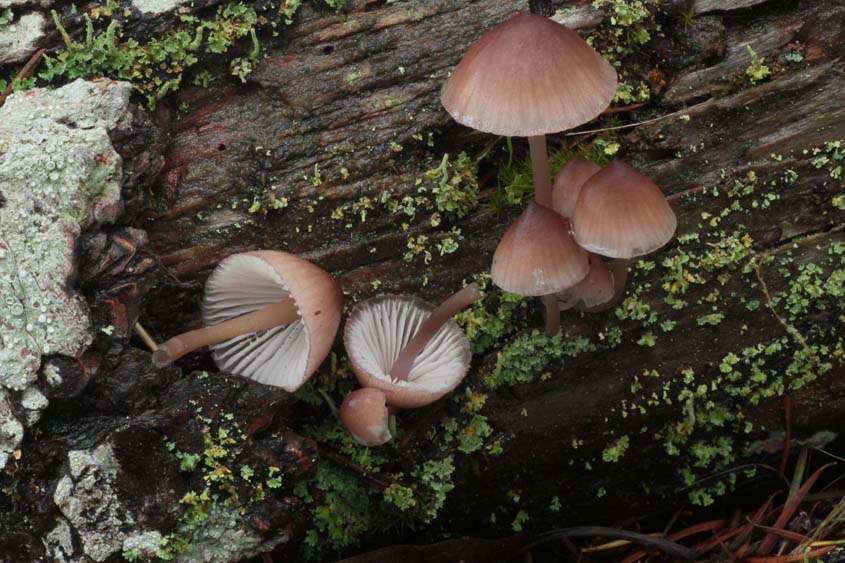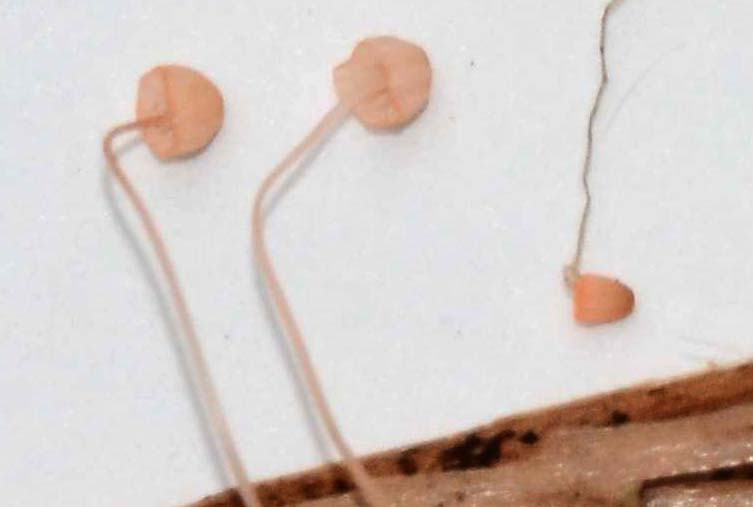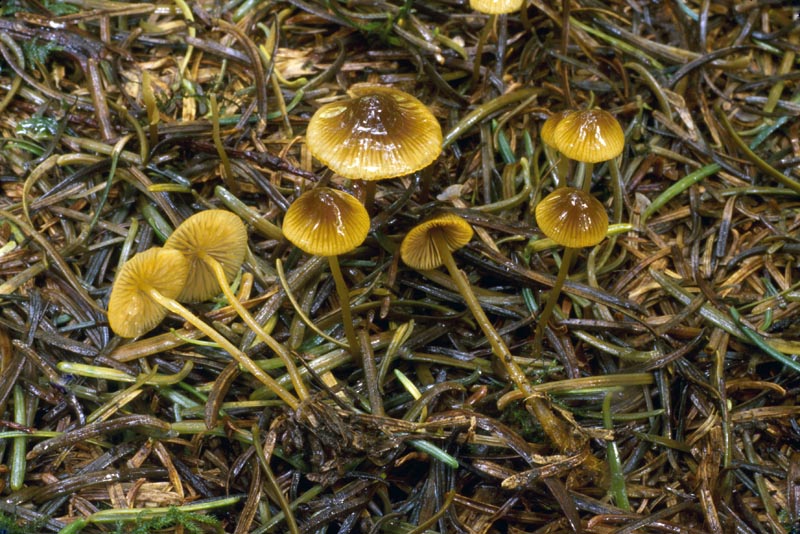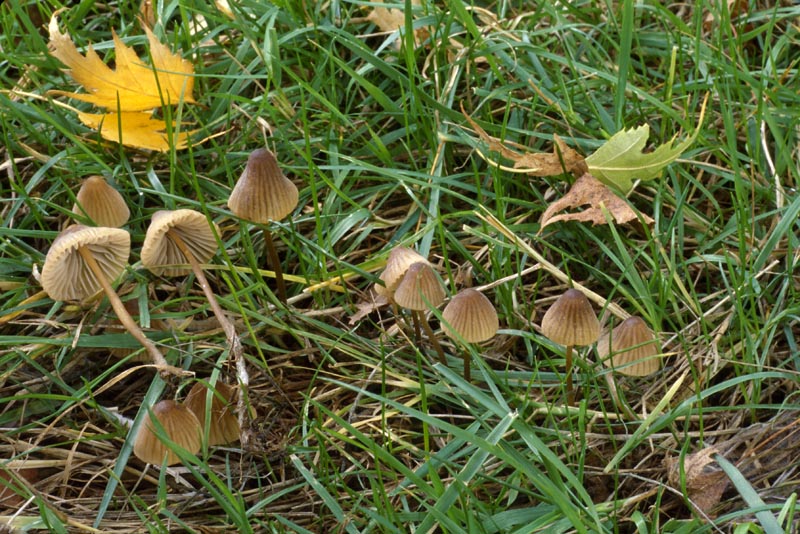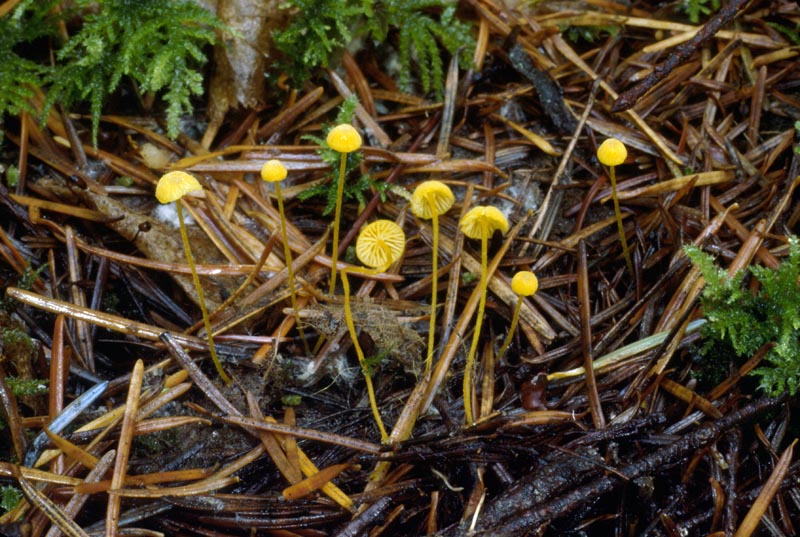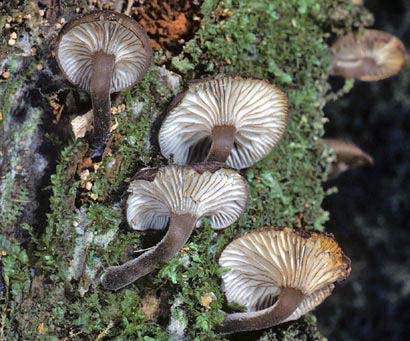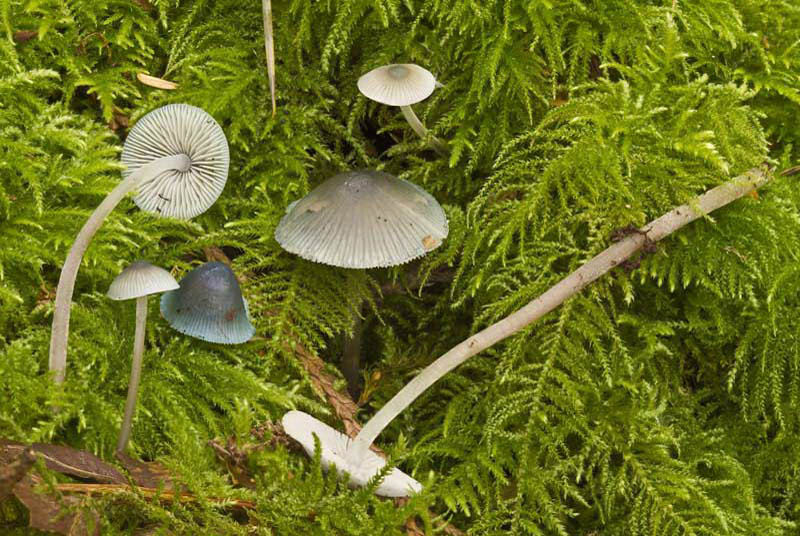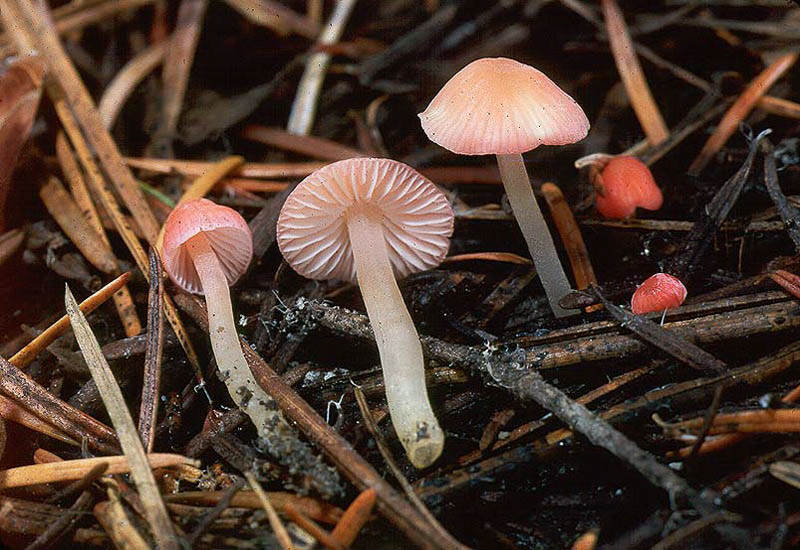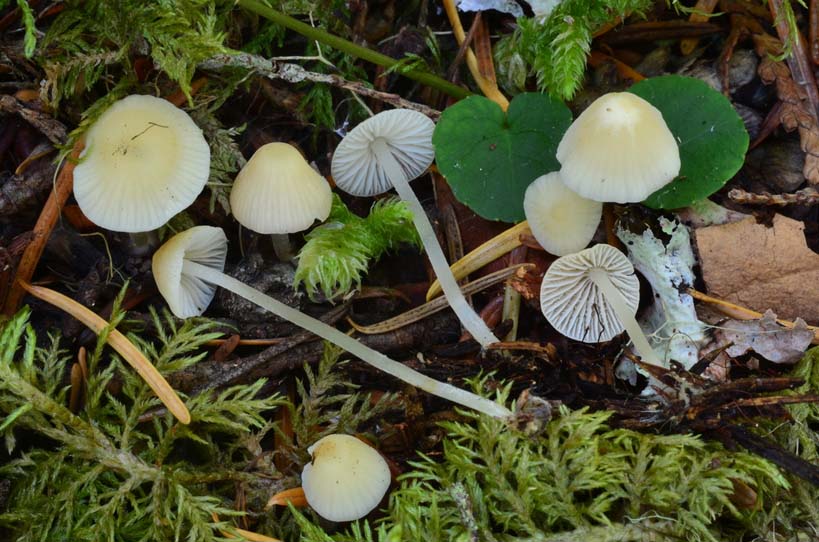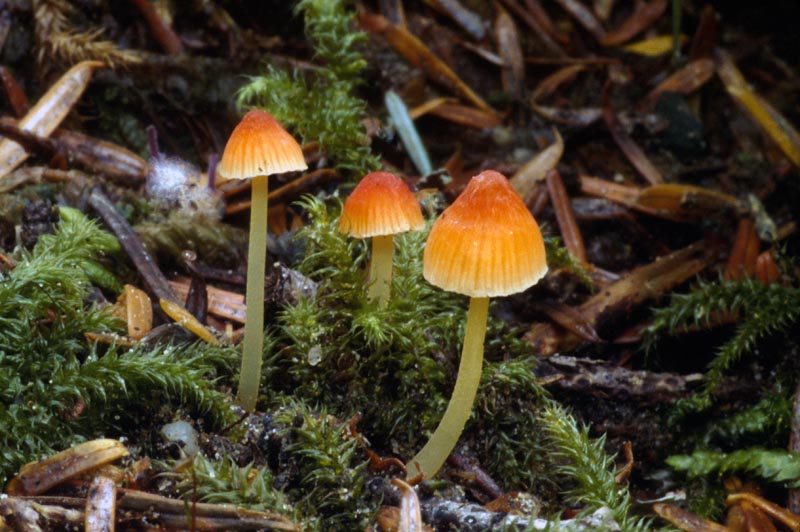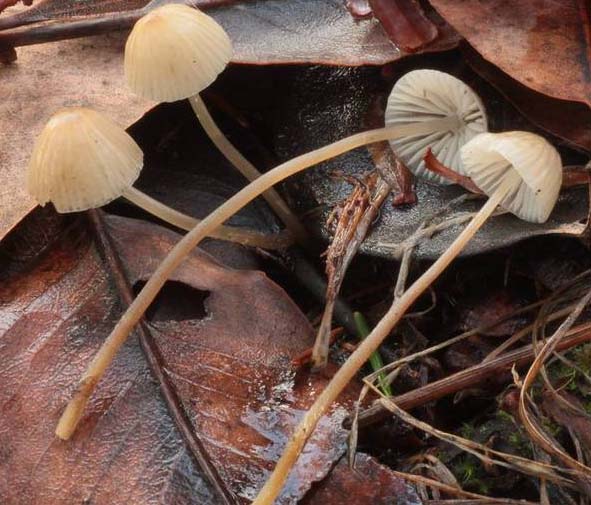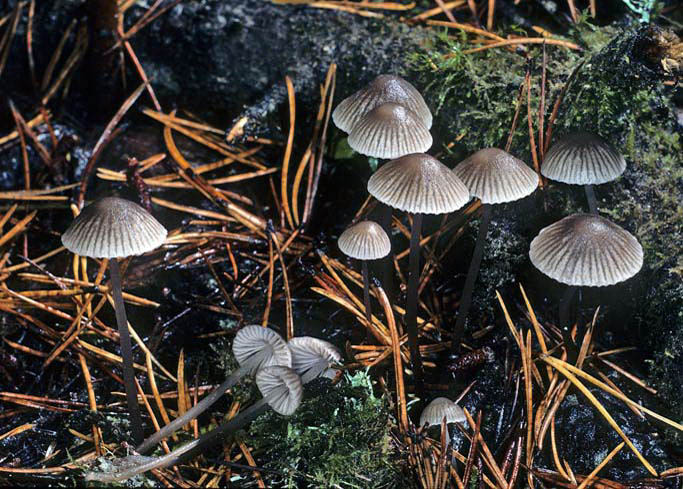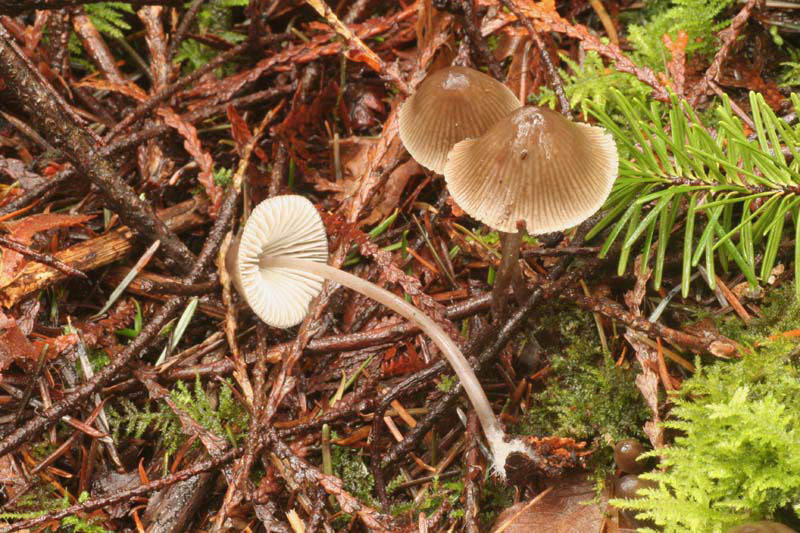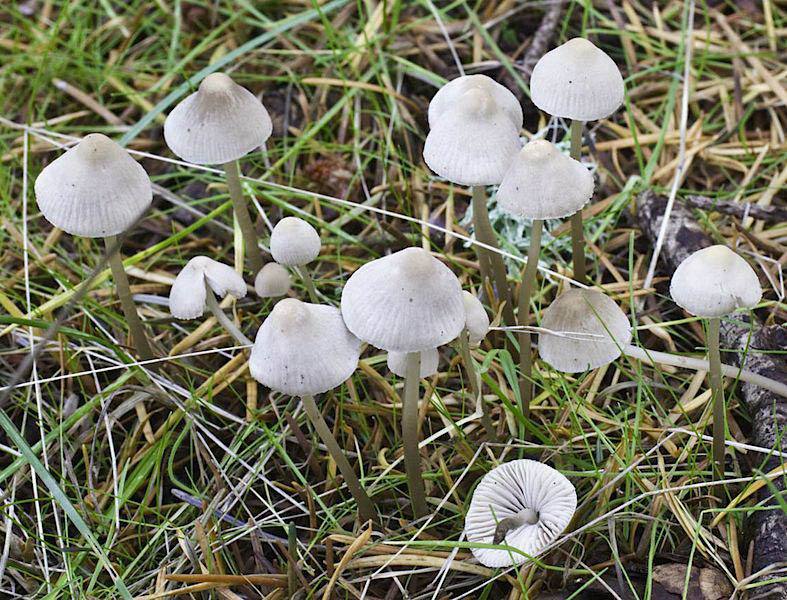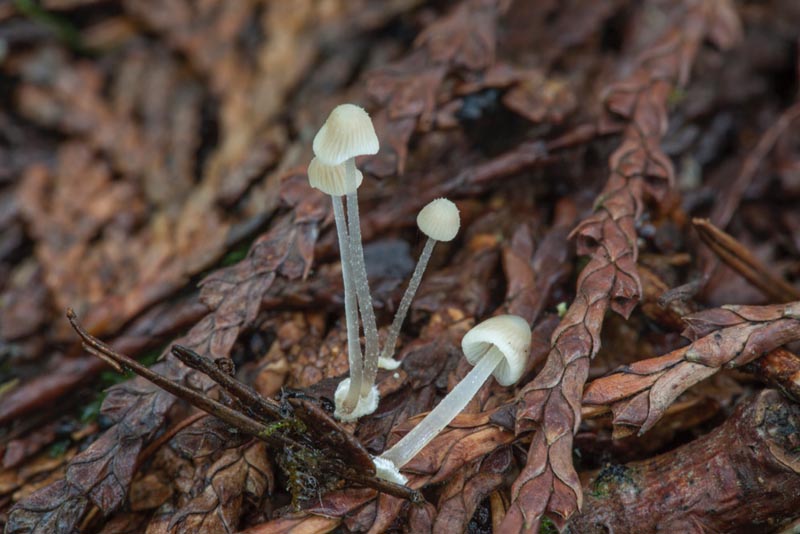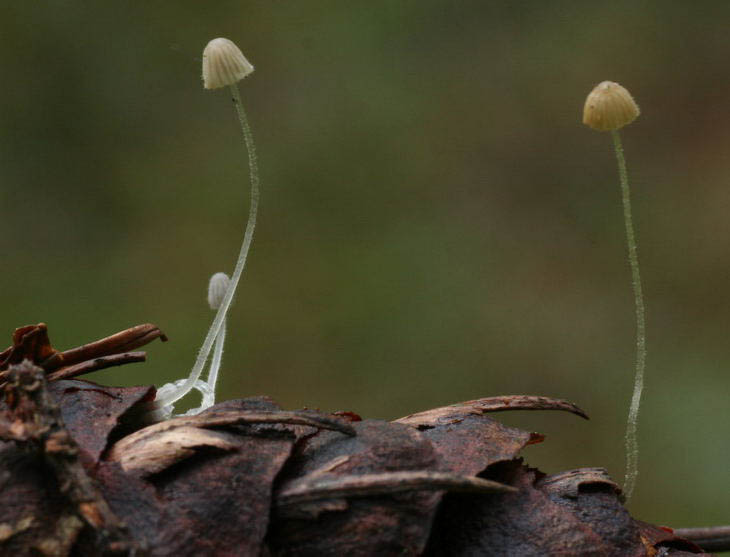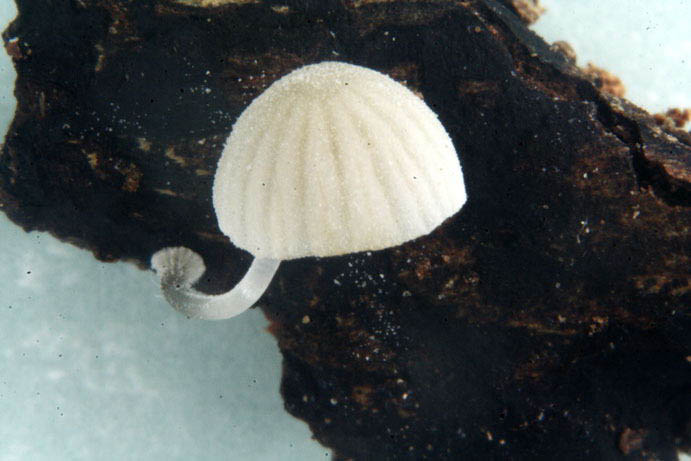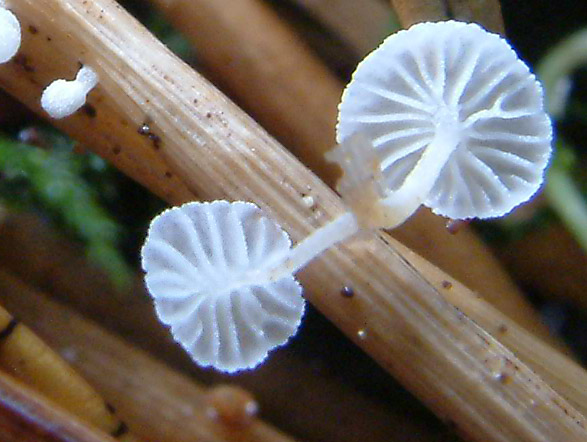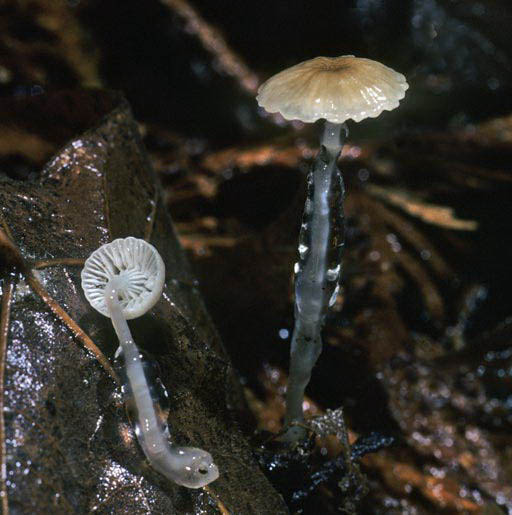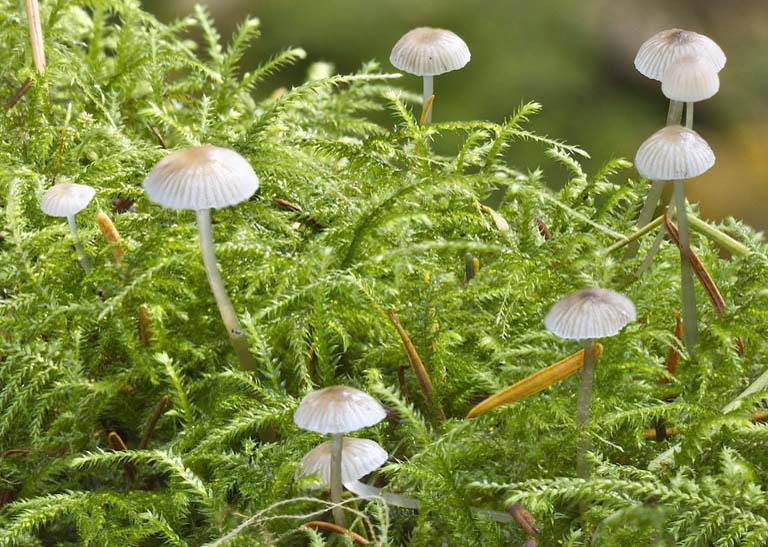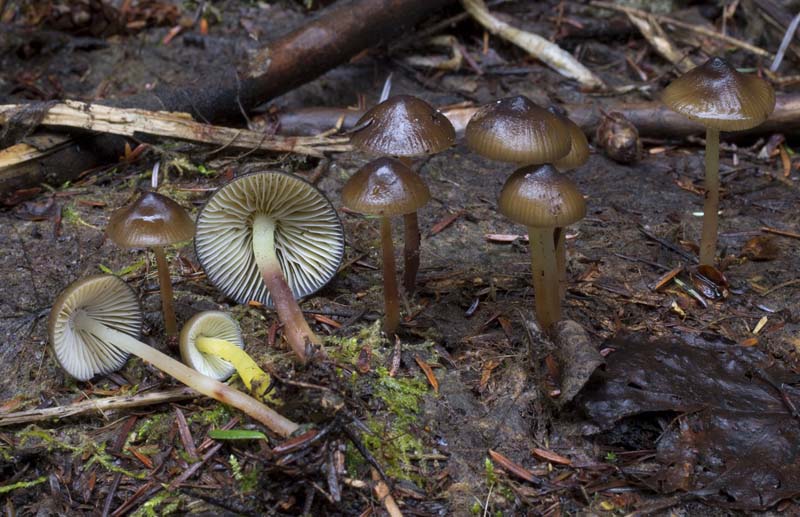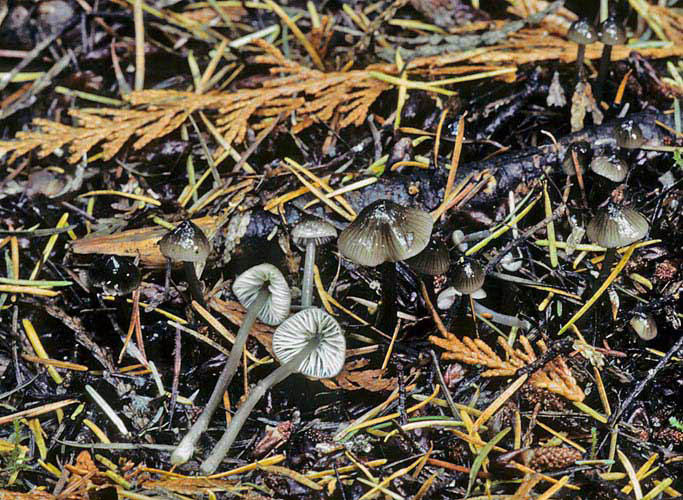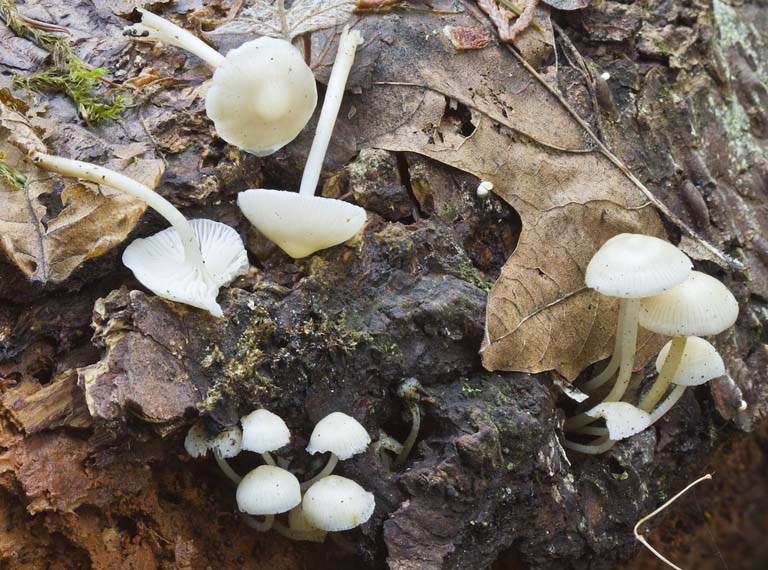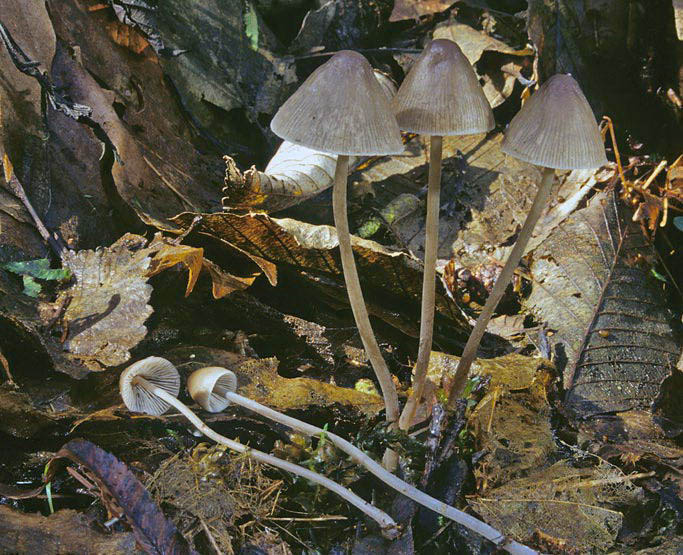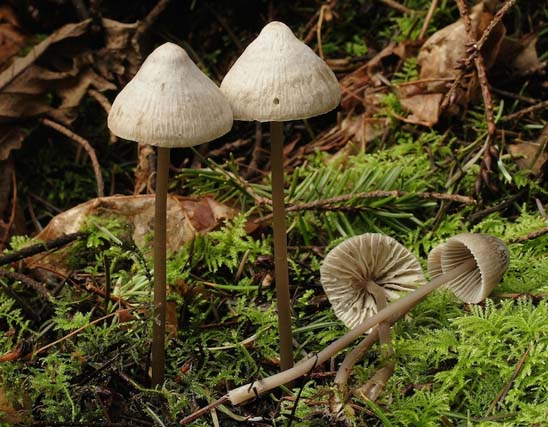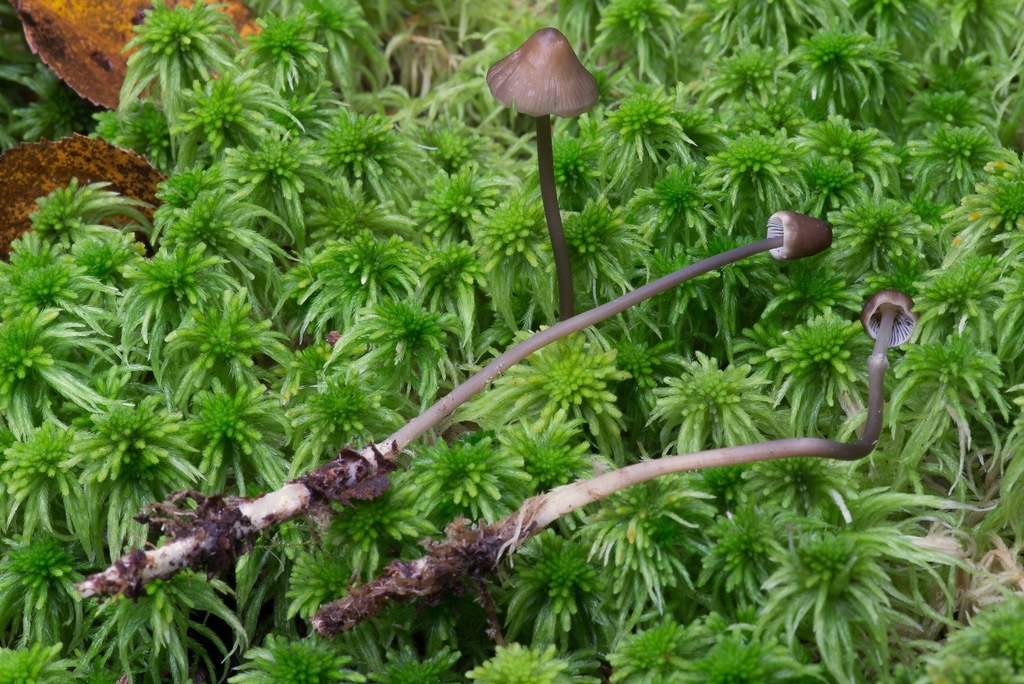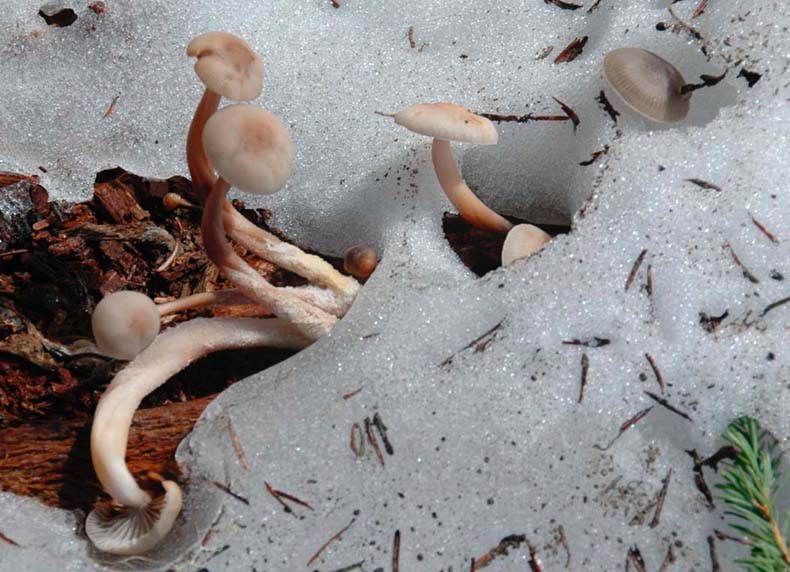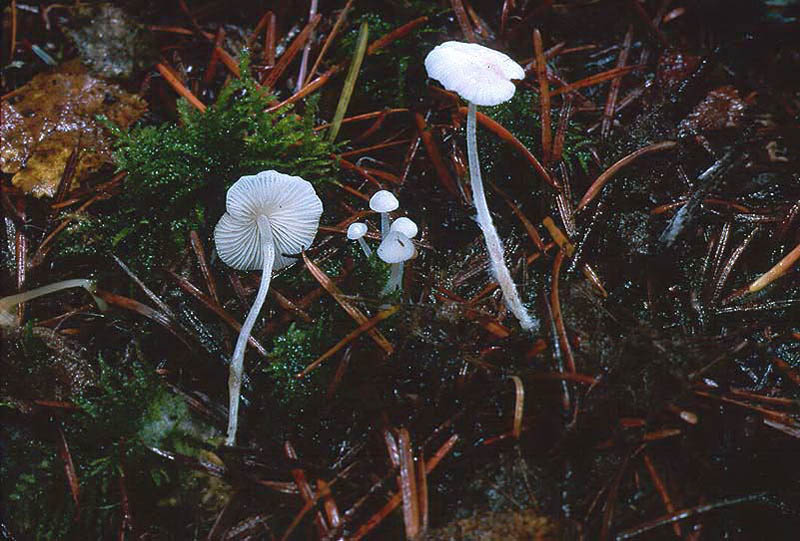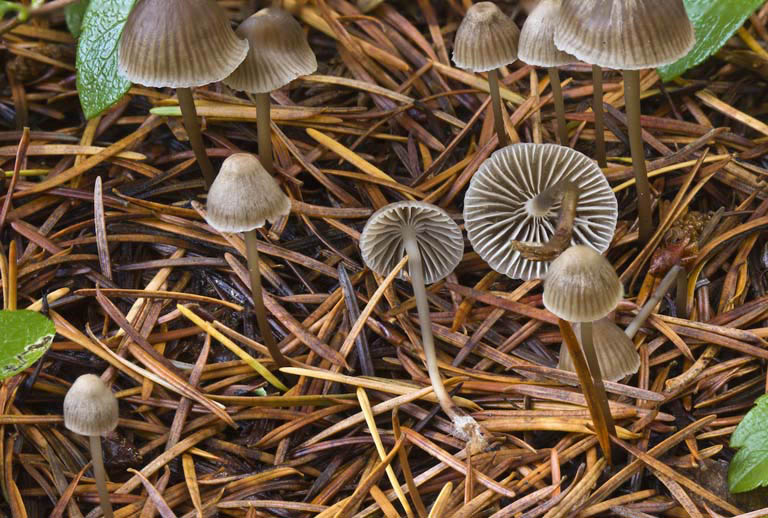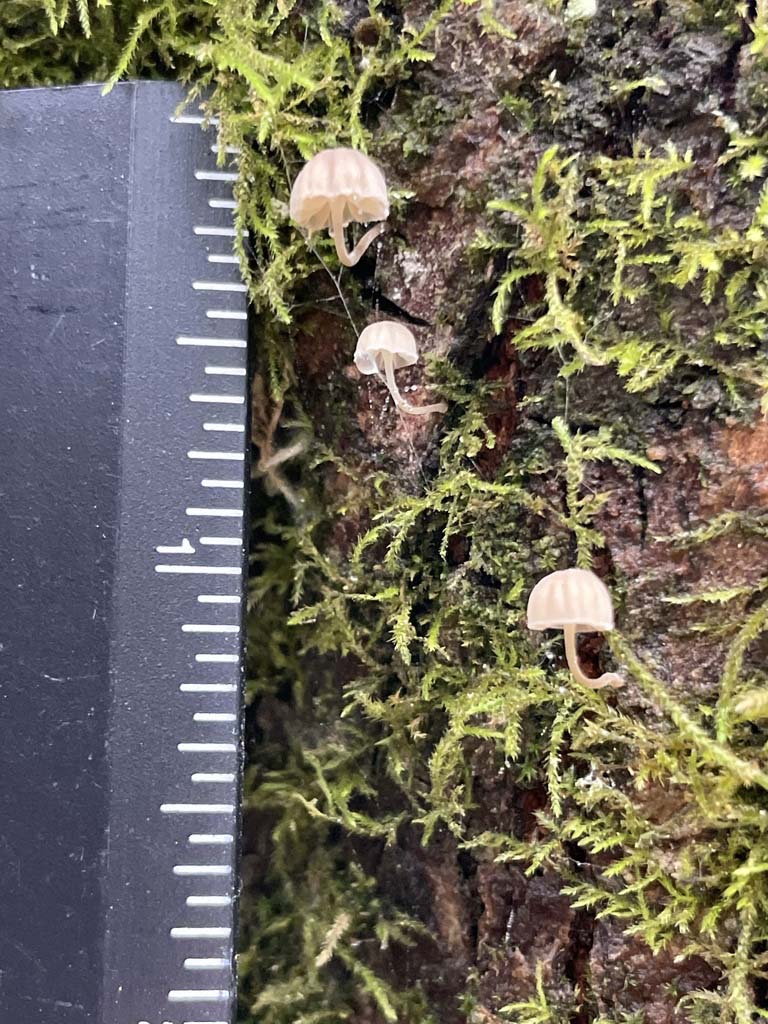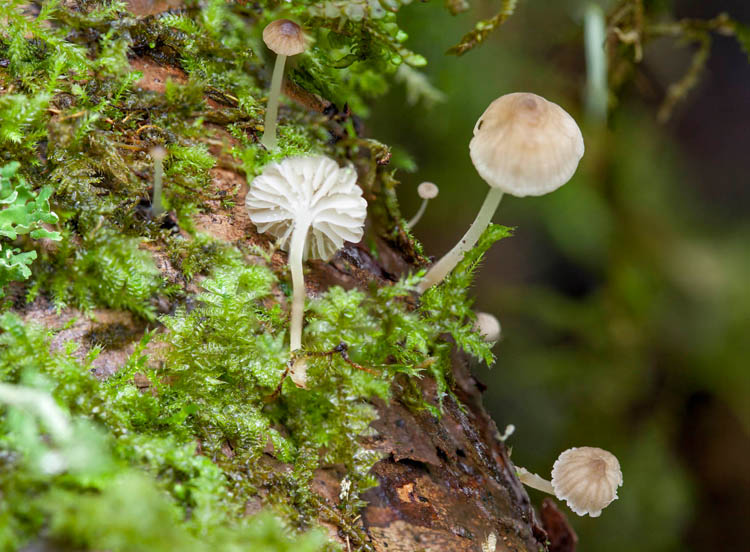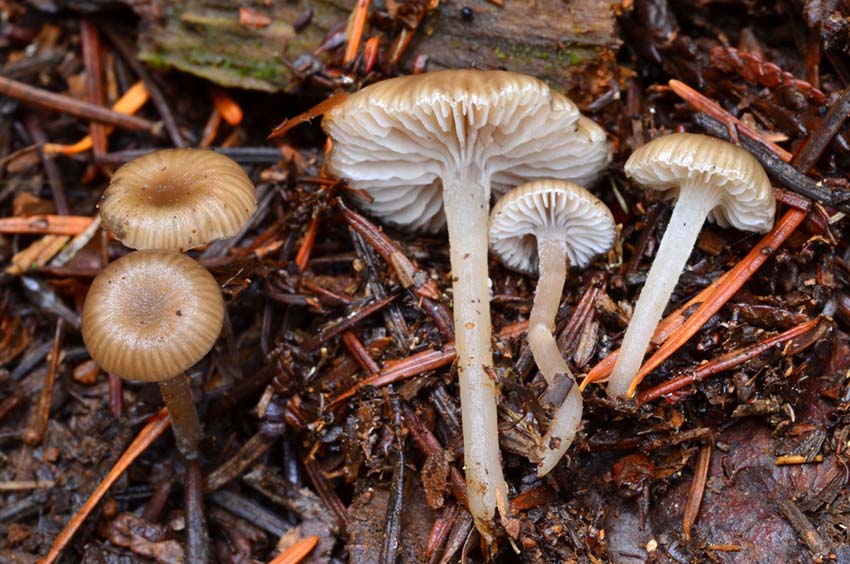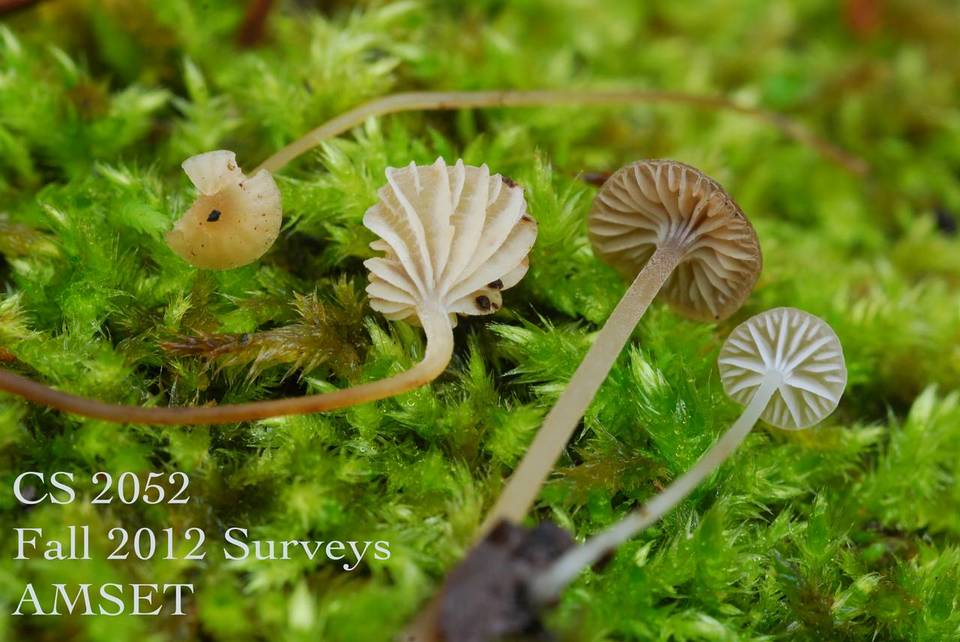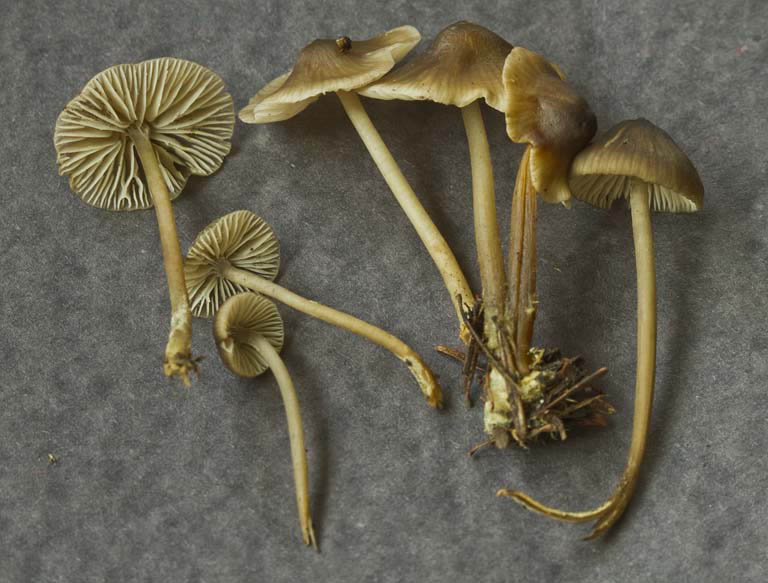Mycenoid
The gill attachment can be virtually anything, but usually appearing adnexed
to adnate, with some species being arcuate.
Sometimes the gills are adnately attached to a "collar" that separates
from the stem to make the gills free, although the species will often be
described as having adnate gills. Found on the ground and/or on various kinds of plant litter
(leaves, needles, wood of all sizes, etc). Most are thought to be
saprophytic.
Many species on this
page are distinguished by having warty outgrowths in the cells of the
cap, even some that aren't in Mycena. Mycena itself has amyloid spores (turn dark in iodine).
Key to cap diameters: (XXS) <5mm, (XS) <1cm, (S) <2.5cm, (M) > 2.5cm.
All are Small (S) unless specified. The medium sized ones are so large you might
not think to look on this page.
Key to Mycena:
- Marginate Gills - look closely and
you'll see the edge of each gill is painted a colour.
- Colourful - some of our prettiest
delicate mushrooms, in bright colours, but gill edges never a
different colour.
- Bleeding Stems - break a fresh stem in
half to see if white milk or red "blood" comes out.
- Odiferous - bleach, iodine,
farinaceous, rancid or other strong
smells.
- Viscid stems - Mycenas with sticky stems
when fresh. Often grey-brown with decurrent gills.
- Basal Disc or Sugary - white Mycenas with a
disc at the bottom of the stem or covered in sugary granules. The gills are
never strongly decurrent.
- Hemimycena - usually white Mycenas without a
viscid stem, basal disc or sugary granules (although a basal disc may be
present if the gills are strongly decurrent). Sometimes so small their name
literally means "half a Mycena".
- Large - they may be plain brownish-grey, but
they're >2.5cm across, unusually large for a Mycena.
- Boring - none of the above. Grey or
brownish. Abandon hope all ye who enter here.
Marginate Gills - Some Mycenas are obviously colourful, but many
also have brightly painted
gill edges which you almost need a magnifying glass to see. That may be
the only bright colour on the fruitbodies. In many cases, the closer you look,
the more beautiful the mushrooms get.
M. purpureofusca - reddish-purple caps fading to
purple-grey with
purple gill edges.
Very similar to the next group in age.
M. rubromarginata/bulliformis - pinkish grey caps,
pink to reddish brown gill edges, perhaps best
differentiated microscopically.
M. viridimarginata - grey cap but
olive gill edges, not confirmed from the PNW.
M. capillaripes - usually more grey than M. bulliformis with the same pink edges, smells like bleach!
M. pterigena - (XXS), pink cap (fading) with pink edges
on dead fern debris.
M. rosella - pink (more so than M. bulliformis),
sometimes coral-pink, fading to orange, with pink edges.
M. rutilantiformis/pelianthina - (M) stature of
M. pura, purple edges. M. rutilantiformis may have a yellow
stem top.
M. strobilinoidea (strobilinoides) - (XS) orange with orange edges.
Fuzzy stem base. Above 2,000'.
M. 'aurantiomarginata' - beautiful olive-yellow-orange cap, orange edges.
M. citrinomarginata (olivaceobrunnea)/chloranthoides - almost
boring brown cap, yellow edges.
M. subsanguinolenta - stem bleeds red, reddish-brown
cap, found on the ground, red gill edges!
These two are not true Mycenas.
'Mycena' oregonensis - (XXS), yellow (to orange), yellow gill edges, on individual
needles.
Inamyloid spores. Needs a new genus.
Hydropus 'marginellus' - brown with brown
gill edges, on wood.
Colourful Mycenas - These next two groups are the colourful Mycenas
(but without coloured gill edges) and they truly are some of our prettiest,
dainty little mushrooms.
M. pura/pearsoniana group - quite large (M), cap flattens in
age, purple fading to
grey, smells
of radish. I've seen blue and albino versions.
M. monticola - pink, sometimes coral-pink. Found
above 2,000'. Darker stem than Atheniella 'adonis', slightly larger.
M. tubarioides - XS
pink
on canes, striate
cap, distant, arcuate gills
M. epipterygia group - slimy yellow stem and cap. Caps grey
or yellow. Edge of the gills can be pulled off as an elastic thread!
M. nivicola/griseoviridis var. cascadensis - robust, distinct member(s) of the
M. epipterygea group, grey cap, dark lower stem.
M. amicta group - blue, fading to two-toned grey or brown,
but still
recognizable by a cap cuticle that peels off.
Alternate
Clades - The following colourful
species have been
separated from Mycena. Except for Hydropus, these do not have amyloid spores.
Atheniella 'adonis' - coral pink
to orange
cap, paler stem than M. monticola.
Atheniella 'flavoalba' - yellow cap fading to white, pale stem.
Atheniella aurantiidisca - 3 shades of orange on cap,
yellowish stem.
'Mycena' acicula group - (XXS), red-orange cap,
yellow stem. Actually near Hemimycena.
'Mycena' oregonensis - (XXS), yellow (to orange), yellow gill edges, on individual
needles.
Needs a new genus.
Hydropus 'marginellus' - brown with brown
gill edges, on wood.
Bleeding Mycenas - Break the stem (and sometime cap), and these
Mycenas will
exude a latex. Do not confuse them
with Lactarius, which are not as frail. There is
plenty of colour in some of these species, as well as one with marginate gills, so you might look for them in the colourful section if you
don't notice the fluid, or if the specimen is old and dry, you may not identify
it.
M. haematopus - bleeds red, often scalloped or velvety
cap spotted red. On wood.
Sometimes with red gill edges.
M. subsanguinolenta - bleeds red, reddish-brown
cap, found on the ground, red gill edges!
M. galopus - white milk, boring grey/brown. You won't
ID it if you don't break the fresh stem.
Unusual Odors - OK, now it's getting harder, but we can still do it. The
following otherwise boring grey-brown Mycenas may have an unusual odor.
You may need to crush the mushroom to detect the odor, just another
reason I sometimes say that I can't tell you what mushroom you have, but I might
be able to tell you what mushroom you used to have.
M. silvae-nigrae - (M), brownish (or greyish),
usually found on actual wood, smells like bleach! Possible
red-brown stains on gills.
M. leptocephala - similar, bleach odor, darker grey-brown
when young, found on the ground or woody debris.
Mycena atroalboides - also dark when young but also fading.
Slight radish odor or possibly bleach? Gills may spot
reddish-brown. Conifer duff.
M. metata group - smells of iodine, at least when dried. May
develop red tones? Stem base may be hairy. Cap
margin may overhang.
M. filopes group - similar, also iodine odor, possibly greyer with no red tones and
a long stem.
M. cinerella -
farinaceous!
contrasting striations.
Arcuate.
M. inclinata - farinaceous or wet paint odor.
M. tenax -
rancid-farinaceous.
Not arcuate. Viscid stem.
M. odorifera
- tiny, dark disc, Matsutake smell.
Viscid stem.
Basal Disc/Sugary - These white Mycenas are recognized by the tiny disc at the
base of the stem or by a sugary appearance. (Mushrooms with strongly
decurrent gills and a basal disc may be a Hemimycena). Their white colour reminds one of
Hemimycena. They will
have hairs or granules on the fruitbodies.
M. stylobates - (XS), long stem, flat basal disc, maybe some
hairy thorns projecting from cap.
M. bulbosa - similar large size and flat basal disc,
no hairs, but a peelable cap cuticle.
M. aciculata ('longiseta') - (XXS), hairy
thorns all over the cap and stem, small bulb at base.
M. gaultheri - (XXS), yellowish, no hairs, flat
basal disc, growing on salal leaves.
M. tenerrima (adscendens)/alphitophora - (XXS), sugary overall
but no hairs, very subtle basal bulb.
M. (Resinomycena) saccharifera/montana - (XS) no bulb, sugary and sticky-resiny on hardwood/conifers.
Viscid Stems - These otherwise boring greyish-brown Mycenas have a viscid stem, and
perhaps also cap. Many have arcuate gills (but so do other nondescript
grey Mycenas). It is unusual for a mushroom to have a viscid stem but not cap,
as the viscidity usually comes from a universal
veil that affects the entire
mushroom, or a special layer of cells in the cap. To have a special layer of
cells in the stem only is unusual.
Mycena rorida (Roridomyces roridus) - (XS). Only the
stem is super-slimy. Arcuate gills.
M. clavicularis - (S). Only the stem is viscid but not ridiculously so.
Arcuate gills.
M. vulgaris - (S). similar, but the cap is viscid too.
M. tenax - (S). viscid stem, peelable cap cuticle, gills
not strongly decurrent, smells rancidly farinaceous.
M. odorifera - viscid cap and stem, arcuate gills,
fruity or Matsutake odor.
M. epipterygia group - slimy yellow stem and cap. Caps grey
or yellow.
M. nivicola - a beefy species in the
M. epipterygea group, grey cap, dark lower stem.
M. quiniaultensis - almost black and
entirely viscid.
Belongs in Mycopan
M. 'laevigata' - off-white and entirely viscid, gills not decurrent, larger than
Hemimycena
and growing on wood.
M. insignis - (XS) whitish, entirely viscid, more arcuate gills, said to bleach
the colour from the needles it grows from.
Large Grey/Brown Mycenas - OK, now things are starting to get difficult, but the
following Mycenas can be recognized by their large size and tendency to
grow in groups or clusters, even though they
are boring greyish-brown like dozens of others. These are all very common,
although of course you have to be in the mountains next to melting snow to find the snowbank species.
The only trouble is, they are so large (perhaps with a flattened cap in age)
that you might not look for them on the Mycena
page. They are all (M) size (>2.5cm at maturity).
M. maculata - on wood,
develops reddish spotting like a large M. haematopus.
M. galericulata - nothing to differentiate it
except its larger size (up to 5cm!), usually on wood.
M. parabolica - similar, usually slightly smaller and more
fragile.
M. hudsoniana
- a distinctly shiny brown, fairly large winter/spring
species, found on the ground from sea level and often higher,
with an umbo and a pale rim.
M. robusta
- a similar larger winter
species, also found on the ground, but more grey than
brown and less shiny.
M. megaspora
- long rooting stems, growing in bogs.
Hemimycena group - these are
recognized by being completely white, and very small with dry
caps and no basal disc nor viscid stem (although there is one species with a
basal disc and strongly decurrent gills and some colourful species). Not hygrophanous (there's no colour to change)! Here are a few of the most common, although in practice they are very difficult to tell apart macroscopically.
They do not have amyloid spores and this genus is going to be split at least 3
ways, but conversely, 'Mycena' acicula needs to be moved to Hemimycena.
Atheniella delectabilis (Hemimycena delectabilis) - (S) white,
arcuate gills,
smells of bleach.
H. delicatella grp (lactea) - (XS) usually
adnate gills often more closely
spaced than others.
H. gracilis - cap may become sordid yellow in age. May not
be a distinct species.
H. albidula - (XS)
decurrent gills,
basal disc at bottom of stem.
H. tortuosa - (XXS), adnate, on
bark. Cool "tortuous" cork-screw cells in the cap.
H. pseudocrispula - XS cap translucent,
decurrent gills.
H. hirsuta/cyphelloides - (XXS)
- no gills! covered in hairs. Might be difficult to
recognize as a gilled mushroom.
'Marasmiellus' filopes - ~2mm!, teensy on conifer needles, with few gills and long
stem. Whitish stem like Hemimycena. Garlic odor in quantity!
Boring grey/brown Mycenas - Does your Mycena have
coloured gill edges, white milk
in the stem or a bleach, farinaceous or
subtle iodine odor (easy to miss)? Did it have a
viscid stem or was it >2.5cm? Many of
these are boring grey or brown and were covered above. Otherwise, read on.
Mycena picta - (XS) often
Omphalinoid in stature, unique looking gills and
distinctly grooved cap.
Mycena atroalboides - dark when young but fading.
Slight radish odor or possibly bleach? Gills may spot
reddish-brown. Conifer duff.
M. amicta group - blue, fading to two-toned grey or brown,
but still
recognizable by a cap cuticle that peels off.
M. meliigena ('corticola') - one of a number of tiny species growing on bark.
Other genera - Boring brownish grey mushrooms,
with nothing at all that I can think of to easily distinguish them. This last
group of photos are not even Mycenas, but since even mycologists have at one
time or other thought they were, you would be forgiven if you did. These are likely Marasmius
relatives: Phloeomana, Mycopan, Hydropus - but these are in the Tricholomatineae: Fayodia, Gamundia,
which have warty spores (Fayodia very much so, and round), and Fayodia and
Mycopan's spores are also amyloid (turn dark in
iodine). Gamundia may look omphalinoid or
clitocyboid. Mycopan and Hydropus are missing the
warty outgrowths in the cap cells, and Hydropus actually has inflated cells like
Marasmius. Most are hygrophanous. Obviously, these species are very difficult to ID.
|
Also consider Tephrocybe for your greyish-brown "Mycena".
|
Phloeomana speirea - (XS) Only a few
arcuate gills,
cap
not really conical, with
grey-brown striations. Spring on bark and sticks.
Fayodia gracilipes (bisphaerigera?) - (S) odd warty
spores, but just a grey/brown Mycena to the naked eye, slightly
decurrent.
Mycopan (Hydropus) scabripes
- (M) much like a large Mycena, umbo, subtle
stem fibres, usually adnate.
Hydropus pseudotenax - (M) - stem is
cartilaginous like in the Marasmius
clade, stem base hairs become yellow, adnate.
There are dozens more grey or brown Mycenas, in fact
many species seem to be sometimes grey and sometimes brown, but I'm going to
stop now. Some people have tried to come up with ways to identify them (like M. subcana and
M. madronicola supposedly only grow on bark) but I don't know of any reliable
way to tell them apart. Heck,
I've probably misled you to think that you can reliably tell apart the species
that I
have included here, as it can be hard even with a microscope. The only
thing more common than a Mycena in the woods is a mycologist looking at one and
saying "Well, it's probably one of the grey-brown Mycenas...". But before I
go I will at least leave you with the names of the some of the grey-brown
species that I cannot tell apart. There is no way to tell how rare they are
because hardly anybody has ever actually inventoried them since Alexander Smith
circa 1940. Perhaps some in the following list are fairly
common, but just not recognized.
M. fuliginella (arcuate gills). M. murina. M. latifolia. M. vitilis. M. fragillima. M. alcaliniformis. M. fagetorum. M. capillaris
(XXS on beech leaves). M. gaultheri is said to be
more yellowish greyish-brown than others favouring dead salal leaves and M. culmigena
is said to be more wine coloured greyish-brown than others on decaying sedges and rushes.
M. megaspora has a somewhat rooting stem. M. tenella
(lohwagii) on fern rhizomes, M. subcucullata and M. deceptor
are usually particularly small.
Mycenas, being small, are often overlooked and not often studied, but as you
can tell from the wide range of colourful species, it can be a
very rewarding group to hunt for.
